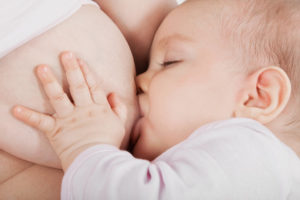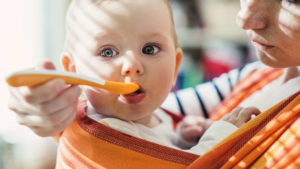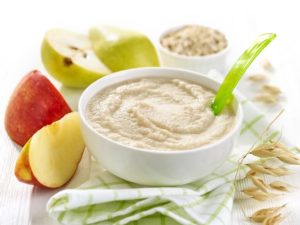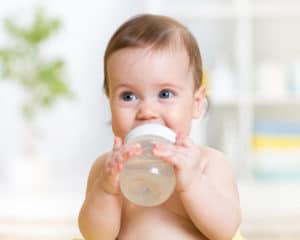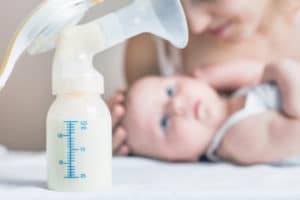No woman can control the flow of milk: At some point, the breasts simply swell and a few drops of milk come out. For some this is painful, others are ashamed of the wet spots.
One thing all breastfeeding women have in common is that their nipples are sensitive. Reusable nursing pads made of silk or cotton protect them. Find out more about this practical aid here.
Table of contents
Nursing Pads: Discreet Inserts Protect The Nipples And Absorb Milk
The ideal nursing pads are made of bourette silk. The slightly rough silk fabric does not stick to the moist skin of the nipples and is slightly antibacterial. It thus prevents inflammation. Silk nursing pads are washable and reusable.
When breastfeeding, simply take the pads off the breast, let your baby drink and then put the pads back in the bra. The only exception: if the nursing pads are wet, you should replace them with fresh ones.
The pads serve a dual purpose. They protect the sensitive nipples and keep them away from rubbing or sticky clothing, and they absorb spontaneously leaking milk.
Nursing pads are a bit like menstrual hygiene: most women don’t talk about it, the subject is embarrassing. Disposable products made of paper and plastic are widespread. In any drugstore, you can find nursing pads made of paper, whose waterproof plastic layer is supposed to prevent clothing from soaking through.
What may be halfway convenient for travel or a day on the town becomes a nuisance for breastfeeding mothers at home. That’s because the paper liners are not breathable. Heat and moisture build-up, softening the skin of already irritated nipples and making them even more sensitive.
At the same time, the moist heat promotes the growth of pathogens. With this mixture, inflammation in the nipples is actually pre-programmed. Nevertheless, you won’t find nursing pads that are reusable in most drugstores and pharmacies – why?
It reminds a few panty liners and pads. These products are also available in every supermarket, made of paper and plastic. The much more hygienic cotton or silk pads, on the other hand, have to be ordered from a specialized store. Which nursing pads are really good, and why should you make sure that nursing pads are washable?
Being A Woman And Being Allowed To Enjoy It
Even though they are not widely available and you may have to search for them: treat yourself to nursing pads made of silk or cotton. The pads are washable, you can use them again and again. This means you don’t need many of them. Most women can get through the entire breastfeeding period with five to ten sets of two pads.
You will need one to three sets per day, depending on how strong your milk flow is. The pads are one size fits all, they are simply round and made of thick fabric. This is especially pleasant in winter: the low temperatures are painful for many women.
Nursing pads protect the nipples from the cold. They lie like an extra-thick layer of clothing over the sensitive breast. Nursing pads made of fabric accompany you throughout the entire breastfeeding period – no matter how long it lasts. Because the washable pads simply last forever.
The reusable pads do not need any foil on the back. Because they are sewn from many layers of fabric, which together act like a dense cushion and are guaranteed not to let any milk on your clothes.
This means that the breathable inserts can simply be placed in clothing – they do not require adhesive surfaces like products sealed with foil. The fabric inserts are held in place by the friction in the nursing bra. This is also gentle on your clothing.
Nursing Pads Made Of Wool And Silk Provide Medical Assistance
When breastfeeding, the skin on the breast suffers. The saliva of your child softens the skin and attacks it. The sucking and pulling movements put additional strain on the skin. And sometimes, of course, your baby bites and chews on the breast. This is completely normal – not only human babies do this.
This behavior can also be observed in mammals. For children, breastfeeding is more than just taking in food. It is closeness to the body, loving care, and also employment, playing, and learning. It is completely normal that your skin reacts stressed and becomes sore or cracked at some point.
In this case, you should use nursing pads made of wool or silk. Silk is a cool material. For nursing pads, the silk is processed somewhat coarser and rough. This prevents the moist skin from sticking to the pad after breastfeeding. Nevertheless, the silk is soft enough so that the pads feel comfortable.
Silk is temperature balancing and cools the skin slightly. The material is permeable to air. These properties help to allow your nipples to recover and heal.
Wool is a little rougher and less smooth. But wool absorbs a lot of moisture. So if you often lose a little milk, for example, during vigorous movements, light pressure on the bosom, or simply every few hours because your baby drinks so much milk, then nursing pads made of wool are right for you.
Wool can absorb an incredible amount of liquid without feeling wet and without releasing it into its environment. Wool, like silk, is a natural protein fiber. The animal fibers don’t provide pathogens with a nutrient base, so they work to counteract infections even when your skin is severely stressed in a moist environment.
Some manufacturers offer nursing pads made of a wool-silk blend. These pads are also washable and reusable. They combine the good properties of wool and silk. Midwives recommend these inserts for healing when the nipples are affected.
Although in this case the insoles are a medical product and are used for therapy, health insurance companies do not pay for them. No matter if the nursing pads are washable and reusable, or if they are disposable: You have to pay for them yourself.
The pads can be washed at 60° C in the washing machine. This is very hygienic. If new cloth inserts are too costly for you, you may be able to take over inserts from a mommy friend or a relative after breastfeeding.
Synthetic Fibers? Bad For The Skin
There’s a lot to be said for reusable nursing pads made from natural fibers. The pads can be washed over and over again, last more than one nursing session, and are good for the skin. But what about pads made from synthetic fibers? After all, there are the small cloth pads made of cotton-synthetic fiber blends or pure microfiber.
The surface of the insoles are made of microfiber and is very, very smooth. The synthetic fibers are supposed to wick moisture inside the nursing pad and keep the skin dry. The very smooth surface is not supposed to stick to the skin. An absorbent core made of cotton (usually molton) absorbs moisture.
Generally, this nursing pad is washable, even suitable for boil wash. Nevertheless, the microfiber material is not as breathable as nursing pads made of pure natural fiber. In addition, there is a layer of polyester on the outside, which is coated with polyurethane – so this is a completely waterproof coating, as used in rainwear.
Such a nursing pad may be very gentle on the customer service representative’s white blouse, but it is not gentle on the lady’s skin. The same problem arises with nursing pads that are made of a silk-wool blend on the inside, but still have synthetic fibers or are even coated with polyurethane on the laundry side.
Nursing pads made of wool and silk cannot be treated in the boil wash. And the coatings made of polyurethane are washable, but cannot withstand a 60° C wash or boil wash either.
Silicone Nursing Pads Suppress The Milk-giving Reflex
As an alternative to nursing pads made of silk, wool, or cotton, as well as blends with synthetic fibers, there are pads made entirely of silicone. These pads do not soak up the leaking milk, but they prevent milk from leaking.
This is because silicone inserts suppress the milk-giving reflex by exerting pressure on the nipples. You don’t even see these pads under your clothes, even under tight clothing they are invisible. According to the manufacturer, these silicone pads are self-adhesive and waterproof. They are also said to be breathable.
If you want to go swimming or do sports while breastfeeding, these pads can be worn inconspicuously. However, they are not so good for the skin and should really only be used in exceptional situations.
And if you want to breastfeed your child at night, it is better not to use these pads at all. They are almost invisible – you might forget to take them out of your clothes. If your child wants to drink at night, the silicone inserts may get on your child’s airways and cover them.
Putting on the silicone inserts is also not easy. In order for the pads to be truly leak-proof, they must be gently pressed onto the nipples when attached. In addition, silicone nursing pads may not work for women with very flat nipples.
If your nipples are rather flat, you should rather use conventional nursing pads made of a soft fabric. Sweating and even the smallest amounts of milk are also problematic in silicone pads. This is because the moisture between the nursing pad and your skin reduces the adhesive properties of the silicone.
In addition, your skin softens due to the moisture, which in turn irritates the skin. You should change silicone pads regularly and clean them thoroughly. Do not use liquid soaps. This is because the re-fattening properties of the soaps destroy the adhesion of the silicone.
Rinsing with a fat-dissolving dishwashing detergent and hot water is sufficient for cleaning silicone inserts. As unpleasant as silicone may sound at first – the nursing pads are washable and reusable. This means that the pads, which are designed for special breastfeeding situations, are even environmentally friendly.
Are Milk Collection Trays An Alternative To Nursing Pads?
If you have a very heavy flow of milk, a conventional nursing pad may not be enough to keep your clothes reliably dry at all times. Milk collection trays can help in this case. The small trays are placed in the bra and are designed to reliably catch leaking milk.
If the trays are hygienic, you can of course still use the milk – whether you give it to your baby to drink or use it in the bathwater is up to you. Breast milk is something very precious, and you should not waste it.
However, breastfeeding advice does not recommend milk collection trays. This is because the cups sit in the bra with slight pressure on the breasts. This increases the leakage of milk – you leak even more.
Since the cups are completely waterproof and not breathable, a warm and humid climate is created inside, which causes sore nipples. In addition, the shells press on the milk ducts at the edges, possibly causing engorgement.
You can better manage heavy milk flow by breastfeeding your baby as needed and as often as possible around the clock. Absorbent nursing pads made of natural fibers are helpful between your baby’s milk feeds
And when the milk-giving reflex kicks in, you can press firmly against the nipple with the heel of your hand for a few seconds. This prevents milk from spurting out. If a little milk does drip out, just use a gauze cloth to catch it. This can also be washed and is always at hand.
By the way, nursing pads can also help you if you are afraid of not having enough milk for your baby. In many cases, this fear is actually unfounded and – like sore nipples – is due to an unfavorable breastfeeding position.
Pay attention to breast care while breastfeeding, so that they hurt less, and take advantage of breastfeeding counseling. You’ll be much more relaxed when you put your baby to the healed breast and know that there’s no pain involved in breastfeeding either.

